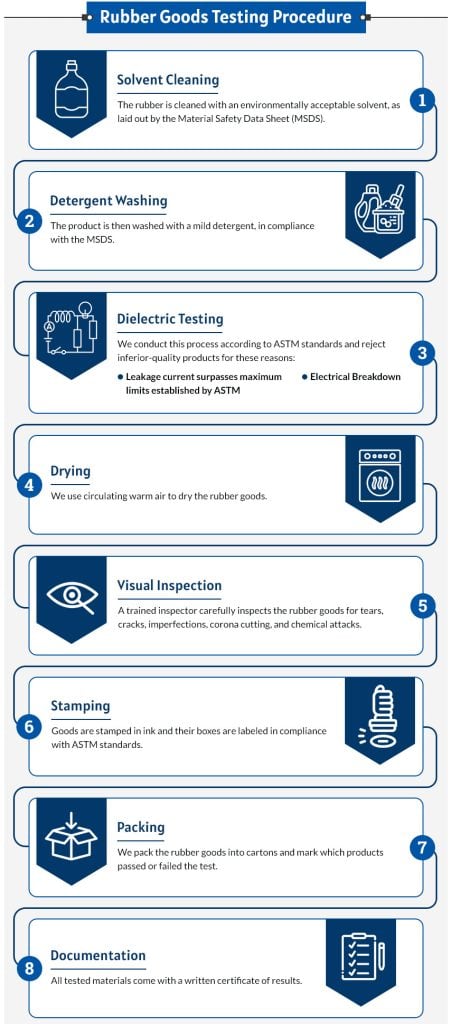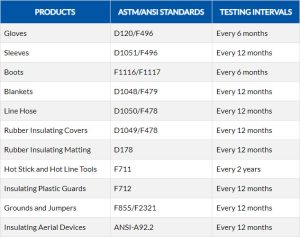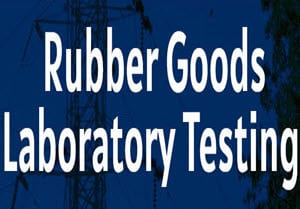Rubber is a common material valued for its versatility and durability, but it can degrade over time. Factors that influence the integrity of rubber products include regular use, environmental changes, improper storage, exposure to sharp objects and dirt, and contact with oil or petroleum.
To keep users safe, ASTM (American Society for Testing and Materials) and OSHA (Occupational Safety and Health Administration) mandate regular electrical and visual inspections. Testing rubber gloves, blankets, boots, sleeves, and other products must meet certain quality standards.
Burlington Safety Laboratory is an industry-leading protective equipment testing lab that provides compliant testing services for rubber goods. Other services include dielectric lab testing, on-site testing, calibration and repairs, and all the most important high voltage personal safety equipment used by linemen.
Rubber Goods Testing Procedure
 Testing rubber goods involves exposing them to an electrical voltage, usually higher than its maximum rated level. The amount of voltage is determined by the rubber’s class, such as ASTM F496: Section 7. The voltage test ensures the product can withstand real-world electrical stress. A hole will burn into the rubber if it fails the test. This is a clear indication of a rubber product unfit for use in electrical applications.
Testing rubber goods involves exposing them to an electrical voltage, usually higher than its maximum rated level. The amount of voltage is determined by the rubber’s class, such as ASTM F496: Section 7. The voltage test ensures the product can withstand real-world electrical stress. A hole will burn into the rubber if it fails the test. This is a clear indication of a rubber product unfit for use in electrical applications.
Here is the step-by-step rubber goods testing procedure that we implement here at Burlington Safety Laboratory:
- Solvent cleaning. The rubber is cleaned with an environmentally acceptable solvent, as laid out by the Material Safety Data Sheet (MSDS).
- Detergent washing. The product is then washed with a mild detergent, in compliance with the MSDS.
- Dielectric testing. We conduct this process according to ASTM standards and reject inferior-quality products for these reasons:
- Leakage current surpasses maximum limits established by ASTM
- Electrical breakdown
- Drying. We use circulating warm air to dry the rubber goods.
- Visual inspection. A trained inspector carefully inspects the rubber goods for tears, cracks, imperfections, corona cutting, and chemical attacks.
- Stamping. Goods are stamped in ink and their boxes are labeled in compliance with ASTM standards.
- Packing. We pack the rubber goods into cartons and mark which products passed or failed the test.
- Documentation. All tested materials come with a written certificate of results.
Benefits of Laboratory Testing Rubber Goods
Although rubber is generally a poor electrical conductor, this does not guarantee that a rubber product is safe for electrical use. Electrical glove testing ensures safety and performance in a reliable, systematic manner. In addition to making your facility compliant, lab testing drastically reduces the risk of field injuries. Keeping workers safe helps you reduce your chances of getting fined by OSHA.
ASTM/ANSI Standards
 Both ASTM and ANSI (American National Standards Institute) are organizations of professionals from many industries—like the electrical industry—that set out guidelines for product safety and testing procedures. Using these regulations, OSHA establishes standards for how people should work in low- and high-voltage environments.
Both ASTM and ANSI (American National Standards Institute) are organizations of professionals from many industries—like the electrical industry—that set out guidelines for product safety and testing procedures. Using these regulations, OSHA establishes standards for how people should work in low- and high-voltage environments.
Burlington Safety Laboratory is fully accredited by the National Association of Independent Laboratories (NAIL) to test electrical protective rubber goods according to the following ASTM/ANSI standards. Certified Rubber Goods Laboratory Testing at Burlington Safety Laboratory
Testing rubber goods, particularly protective equipment, is vital to ensuring the safety of users in electrical environments. Since 1971, Burlington Safety Laboratory has been testing protective equipment for clients in a variety of industries. Our rubber testing lab has pioneered new insulating technologies for personal protective equipment. Our protective equipment testing measures are accredited by NAIL, and all other testing procedures meet Mil-Spec, NFPA 70E, CAL OSHA, and ASTM/ANSI standards.
Learn more about our electrical equipment testing services, or browse our products. Contact us to discuss how we can help keep your facility safe and compliant.

